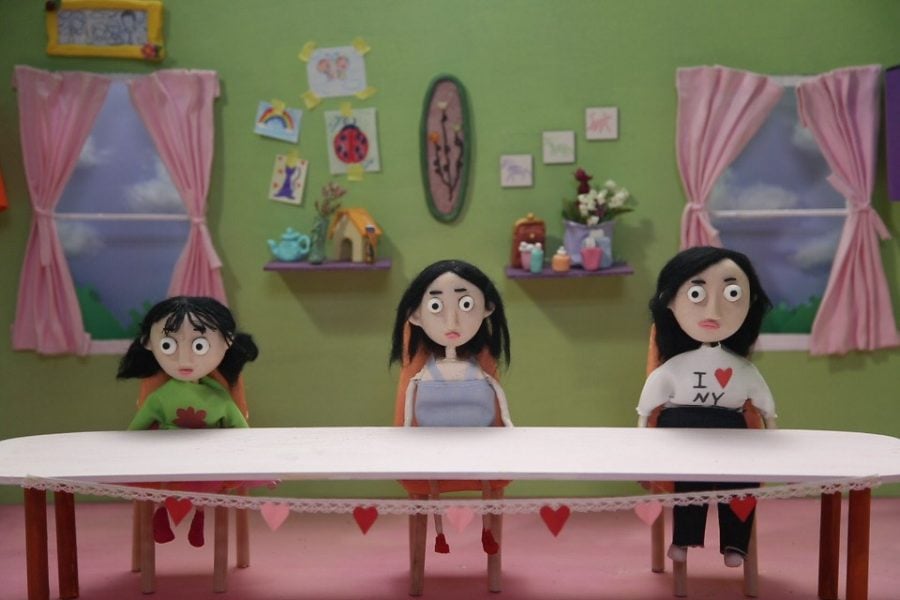‘Shelf Life’ goes small-scale for the big screen: Student-produced film uses stop-motion to fit its set on pool table
May 24, 2022
A crew of Northwestern students assembled miniature food props in the basement of St. Mark’s Episcopal Church last spring. They designed an entire film set on top of a pool table and used tweezers to adjust the facial expressions of small puppets.
“Shelf Life” is a short, dystopian stop-motion film about the intersection of female aging and food. After a year of preparation, filming and editing, student production company Studio 22 will premiere the film June 4.
Communication senior Erin Zhang wrote and directed “Shelf Life.” She began working on the script after quarantining in 2020, when she realized she often had negative thoughts about food and aging.
“I have always been fascinated and fearful of the concept of age,” Zhang said. “I like to explore themes that really scare me.”
The protagonist in “Shelf Life” is inspired by Zhang’s personal experience with food and womanhood. She said she notices a heavy emphasis on consumption in her life, and the story’s dystopian nature reflects her own views about the world’s future if food remains a significant part of femininity.
Instead of having a vendetta against food, Zhang said she hopes the film will be a “wake-up call” for herself and others who resonate with the story.
“Writing ‘Shelf Life’ has made me realize how food can open up more social and cultural moments,” Zhang said. “Instead of making what I ate today personal or indicative of something good or bad, I treat food as a complex subject with nuance.”
Zhang received a Studio 22 Bindley Grant to produce “Shelf Life” last spring. While the grant typically goes toward projects like live-action films, which only require about three months of preparation, the stop-motion process began a year before filming.
During fall and winter 2021, art crew members, producers and editors constructed props, puppets and scenery during their weekly studio time. The team worked in the basement of St. Mark’s, a quiet, ideal place for what Communication sophomore Sofia Veraza described as “grown-up arts and crafts.”
Veraza is one of the producers of “Shelf Life.” She said she enjoyed the tight-knit community among crew members. Because the production did not require a sound or camera crew, the group was smaller and had more flexibility. For example, art crew members would assemble and take down cameras during shoots.
“It’s really nice that we’re able to be fluid and there’s no hierarchy,” Veraza said. “There are no ‘above-the-line’ or ‘below-the-line’ workers.”
Veraza also participated in creating the set. She made miniature lamps and a bedroom that appear during the protagonist’s girlhood scenes.
Many crew members, including Veraza, had little or no experience with stop-motion prior to “Shelf Life,” so the project was a learning experience for all.
Once the shooting process began, Zhang said the art crew turned into the animation crew. Instead of making tiny food items or building scenery, crew members began sculpting puppets’ facial expressions and movements.
“It’s easy to forget that we’re all students, and we’re all learning,” Veraza said. “Being more of a creative producer has been so fun for me.”
Zhang said embarking on a project where she had creative control over each precise movement was an exciting challenge. She said there was a sense of camaraderie as everyone learned and worked together.
Communication junior Tanya Herrmann, a Studio 22 film manager, kept the film on schedule and provided support. Even though stop-motion was a “mystery” to her, Herrmann said she was drawn to the film.
“The script had a really distinct tone and kind of a dystopian feel,” Herrmann said. “I was really impressed by how ambitious of a project it was.”
Zhang and Herrmann said creating a stop-motion film was motivating because film sequences were ready to watch in real time. Instead of waiting to see end results post-production, crew members could view animation clips during sets.
Zhang said it was rewarding to see film sequences come to life as the team worked. She said many individuals on set were excited about working with stop-motion because it is a unique storytelling medium.
“Focusing on new, alternative mediums is something people have been hungry for,” Zhang said. “I hope this opens new doors for classes and (Radio, Television and Film) students in terms of what they think is possible.”
Email: [email protected]
Twitter: @ash_goren
Related Stories:
—A&O Productions, Sherman Ave. announce Patti Harrison and Sarah Sherman as spring speakers
—“Fools Who Dream”: RTVF students plan film festival by artists, for artists


